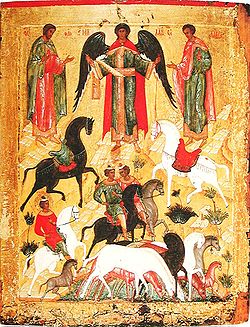Top Qs
Timeline
Chat
Perspective
August 18 (Eastern Orthodox liturgics)
From Wikipedia, the free encyclopedia
Remove ads
August 17 - Eastern Orthodox liturgical calendar - August 19

All fixed commemorations below are observed on August 31 by Eastern Orthodox Churches on the Old Calendar.[note 1]
For August 18, Orthodox Churches on the Old Calendar commemorate the Saints listed on August 5.
Feasts
Saints
- Martyrs Florus and Laurus of Illyria, twin brothers who worked as stonemasons (2nd century)[1][3][4][5][note 3][note 4]
- The Holy Host of Paupers (300 martyrs), brought together by Saints Florus and Laurus, who smashed the statues of the pagan gods and were martyred by fire.[7][8][note 5]
- Martyrs Hermes, Serapion, Polyaenus of Rome (2nd century)[1][5][9][10][note 6]
- Hieromartyr Emilian, Bishop of Trebia in Umbria, and lay martyrs Hilarion, Dionysius, Hermippus, and about 1,000 others, in Italy (c. 300)[1][11][12][note 7]
- Venerable Barnabas and his nephew Sophronius, founders of Mount Mela Monastery (Panagia Soumela), near Trebizond (412)[1][5][15][16]
- Venerable Christopher of Trebizond, Abbot of Mount Mela Monastery (Panagia Soumela) (668)[1][5][15][17]
- Saints John (674)[18] and George (683),[19] Patriarchs of Constantinople.[1][5][20]
- Martyr Juliana near Strobilos in Lycia.[1][5][6][21][note 8]
- Martyr Leo, drowned off the coast of Myra in Lycia.[1][5][6][22][note 9]
- The 4 Venerable Ascetics, reposed in peace.[23][24]
- Saint Macarius, Abbot of the Pelekete monastery near Prusa, Bithynia (840)[1][25][26] (see also: April 1)
- Venerable John of Rila, founder and Abbot of Rila Monastery, Bulgaria (946)[1][25][27] (see also: October 19)
Remove ads
Pre-Schism Western saints
- Saint Agapitus of Palestrina, a fifteen-year-old who bravely confessed Christ and was martyred in Palestrina near Rome (c. 274)[28][note 10]
- Martyrs John and Crispus, priests in Rome who devoted themselves to recovering and burying the bodies of the martyrs, for which they also suffered martyrdom.[28][note 11]
- Saint Firminus of Metz, Greek or Italian by origin, he was Bishop of Metz in France for eight years, Confessor (496)[6][28]
- Saint Daig Maccairill (Daig, Dagaeus, Daganus), disciple of St Finian, he founded a monastery at Inis Cain Dega (Inniskeen), and was both abbot and bishop (586)[28]
- Saint Milo, a monk together with his father at Fontenelle Abbey in France, and later a hermit (c. 740)[28]
- Saint Inan (Evan),a hermit in Ayrshire in Scotland, where churches are dedicated to him (9th century)[28]
Post-Schism Orthodox saints
- Saint Christodoulus the Philosopher, called "the Ossetian," of Georgia (12th century)[1][25][29]
- Venerable Sophronius of St. Anne's skete on Mount Athos (18th century)[1][5][30][31]
- New Monk-martyr Demetrius the Vlach, of Samarina (Pindos), at Ioannina (1808)[1][5] (see also: August 17)
New martyrs and confessors
- New Hieromartyrs Archimandrite Augustine of Orans Monastery,[note 12] and Archpriest Nicholas of Nizhni-Novgorod, and 15 people with them (1918)[1][25][32]
- New Hieromartyr Gregory Bronnikov, Priest, and Martyr Eugene Dmitriev and Michael Eregodsky (1937)[25]
Remove ads
Other commemorations
- Uncovering of the Relics of Venerable Arsenios the New of Paros (1877)[5][33][34]
- Repose of Schemamonk Nicholas "the Turk," of Optina Skete (1893)[1]
Icons
- Icon of the Mother of God the "Directress" ("Hodegetria") of Trebizond, also known as "Panagia Soumeliotissa".[25][32][35]
Icon gallery
- Hieromartyr Emilian, Bishop of Trebia in Umbria.
- Mount Mela Monastery (Panagia Soumela), founded by Barnabas and Sophronius, and later Christopher of Trebizond.
- St. John of Rila, fresco from Rila monastery, Bulgaria.
Notes
- The notation Old Style or (OS) is sometimes used to indicate a date in the Julian Calendar (which is used by churches on the "Old Calendar").
The notation New Style or (NS), indicates a date in the Revised Julian calendar (which is used by churches on the "New Calendar"). - "On the third day of the Afterfeast of the Dormition, the hymns at Vespers call upon us to "sing the praises of the pure and most holy Virgin." She did not ascend to heaven in a chariot of fire, as did the Prophet Elias, but "He Who is truly the Sun of Righteousness" received her pure soul."[2]
- "When the construction of the temple was completed, the brothers gathered the Christians together, and going through the temple, they smashed the idols. In the eastern part of the temple they set up the holy Cross. They spent all night in prayer, illumined with heavenly light. Having learned of this, the head of the district condemned to burning the former pagan priest Mamertin and his son and 300 Christians."[4]
- The Book of Saints compiled by the Benedictine Monks of St. Augustine's Abbey, Ramsgate (1921), has the following two entries for these saints:
- "AEMILIAN (St.) Bp. M. (Feb. 8). "Some writers, however, identify this St. AEmilian with another Martyr of the same name, likewise an Armenian, venerated at Trebbia (Trevi) in Central Italy, as first Bishop of that city (4th century).[13]
- DIONYSIUS, AEMILIAN and SEBASTIAN (SS.) MM. (Feb. 8). (Date unknown). "The Roman Martyrology describes them as Armenian monks; but there have been disputes among the learned as to the nationality of some of them. In reality we are no longer in possession of anything like adequate evidence bearing on their date, lives or martyrdom."[14]
- Possibly the same saint as is commemorated on December 21.
- Possibly the same saint as is commemorated on February 18.
- "AT Palestrina, the birthday of the holy martyr Agapitus. Although only fifteen years of age, as he was fervent in the love of Christ, he was arrested by order of the emperor Aurelian, and scourged a long time. Afterwards, under the prefect Antiochus, he endured more severe torments, and being delivered to the lions by the emperor's order without receiving any injury, he was finally struck with the sword, and thus merited his crown."[6] He is the patron-saint of Palestrina, where as early as the fifth century a church was dedicated to him.
- See also: (in Russian) Оранский Богородицкий монастырь. Википедии. (Russian Wikipedia).
Remove ads
References
Sources
Wikiwand - on
Seamless Wikipedia browsing. On steroids.
Remove ads





